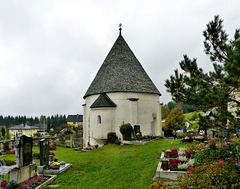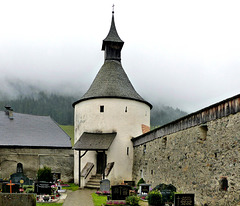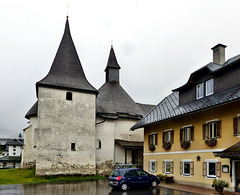
Carinthia / Kaernten
All photos were taken in Carinthia, the southernmost Austrian state.
Gurk - Dom
| |
|
In 1043 Hemma of Gurk (canonized in 1938) founded the Benedictine double monastery of Gurk Abbey, where she withdrew during the last years of her life.
After Saint Hemma´s death, the abbey was dissolved by the Archbishop of Salzburg, who instead set up the Diocese of Gurk-Klagenfurt in 1072.
The "Gurk Cathedral" is a Romanesque basilica, built 1140 - 1220. The crypt got consecrated already in 1174 and since then hosts the grave of Saint Hemma of Gurk, still a place of pilgrimage. In 1988 even Pope John Paul II visited the cathedral and prayed in the crypt at the grave of Saint Hemma.
Of course the tomb is secured behind intricate iron lattice work, but peeking through the grills, the visitors can see the head of Saint Hemma.
Gurk - Dom
| |
|
|
|
In 1043 Hemma of Gurk (canonized in 1938) founded the Benedictine double monastery of Gurk Abbey, where she withdrew during the last years of her life.
After Saint Hemma´s death, the abbey was dissolved by the Archbishop of Salzburg, who instead set up the Diocese of Gurk-Klagenfurt in 1072.
The "Gurk Cathedral", seen here from a nearby hill, is a Romanesque basilica, built 1140 - 1220. The crypt got consecrated already in 1174 and since then hosts the grave of Saint Hemma of Gurk, still a place of pilgrimage. In 1988 even Pope John Paul II visited the cathedral and prayed in the crypt at the grave of Saint Hemma.
Pisweg - St. Lambert
| |
|
St. Lambert, parish church of the village of Pisweg, today a part of Gurk, was mentioned the first time in 1164. As the church of today was Romanesque and got altered into a Gothic church later, it may well be, that it did exist already within the 12th century.
The round Karner (ossuary) is dated to the 13th century
Pisweg - St. Lambert
| |
|
St. Lambert, parish church of the village of Pisweg, today a part of Gurk, was mentioned the first time in 1164.
The round Karner (ossuary), next to the church, is dated to the 13th century. Now used as a war memorial it is known for the frescoes under the dome.
Pisweg - St. Lambert
| |
|
|
|
St. Lambert, parish church of the village of Pisweg, today a part of Gurk, was mentioned the first time in 1164.
The round Karner (ossuary), next to the church, is dated to the 13th century. Now used as a war memorial, it is known for the frescoes under the dome.
Here is a segment of the frescoe, painted around 1280, following the style of the frescoes in Gurk.
The keystone has the "Agnus Dei". There are Adam and Eve in paradise just before they accept the apple. Below the Magi, arriving in Bethlehem.
The Magi are often connected to pilgrimage. The Magi were the heroes of the medieval pilgrims. Pisweg may have been the last halt for many on the way to Saint Hemma´s tomb in Gurk, only about 5kms away. Time for the last rosary...
Lieding - Hl. Margaretha
| |
|
A church was founded here by in 974 by Countess Emma, Saint Emma of Gurk´s grandmother. Since 1131 this church served the parish.
After a fire in 1200, the church got rebuilt, of the older church the walls of the nave and a part of the narthex got "reused". The large Gothic (unfortunately locked) crypt got added 1330 - 1350. During the Turkish incursions in the second half of the 15th century the church and the surrounding area got fortified, while in "Baroque times" the tower got a new bulbous spire.
The chapel on the left once served as Karner (ossuary).
Lieding - Hl. Margaretha
| |
|
A church was founded here by in 974 by Countess Emma, Saint Emma of Gurk´s grandmother. Since 1131 this church served the parish.
After a fire in 1200, the church got rebuilt, of the older church the walls of the nave and a part of the narthex got "reused". The large Gothic (unfortunately locked) crypt got added 1330 - 1350. During the Turkish incursions in the second half of the 15th century the church and the surrounding area got fortified, while in "Baroque times" the tower got a new bulbous spire.
The chapel on the right once served as Karner (ossuary). Seen in the backdrop is "Schloss Straßburg". The castle, overlooking the valley of the Gurk-river, was the residency of the Bishops of Gurk.
Lieding - Hl. Margaretha
| |
|
A church was founded here by in 974 by Countess Emma, Saint Emma of Gurk´s grandmother. Since 1131 this church served the parish.
After a fire in 1200, the church got rebuilt, of the older church the walls of the nave and a part of the narthex got "reused". The large Gothic (unfortunately locked) crypt got added 1330 - 1350. During the Turkish incursions in the second half of the 15th century the church and the surrounding area got fortified. The iron door, seen here, may have been installed during that rough time.
The tympanum above, protected by a narthex, originates probably from the very first church here. Following the infomation I found, there is Saint Margaretha devoured by a dragon and saved by a lion. Behind Saint Margaretha´s head is a second head visible. Maybe an angel watching the dramatic scene.
Straßburg
| |
|
Straßburg, seen from the churchyard of Lieding.
"Burg Straßburg", towers over the valley. It was built from 1147 on by the Bishops of Gurk and served as their residence until November 1767, when an earthquake ruined Straßburg. Between castle and town is the Maria Loretto chapel from 1650. Located in the town center is the parish church St. Nikolaus.
Straßburg - Hl. Geist
| |
|
Gerold of Friesach founded a hospital for the poor just west of Straßburg in 1337, when he was Bishop of Gurk. The round early-Gothic church may have been part of this infirmary already then, it was mentioned the first time in 1407.
The church got enlarged and altered later. Unfortunately it was locked.
Zweinitz - St. Ägidius
| |
|
The church, dedicated to St. Ägidius (= "Saint Gilles") was mentioned the first time in 1169, though a legend tells, that it was founded by Saint Hemma of Gurk.
Rebuilt after a fire in 1354 it has been dependent from the Canons of Gurk upto 1781. It is located in the center of the village´s graveyard.
The ridge turret is pretty new, it was added to the church in 1929.
Zweinitz - St. Ägidius
| |
|
|
The church, dedicated to St. Ägidius (= "Saint Gilles") was mentioned the first time in 1169, though a legend tells, that it was founded by Saint Hemma of Gurk.
Rebuilt after a fire in 1354 it has been dependent from the Canons of Gurk upto 1781. It is located in the center of the village´s graveyard.
The portal, protected by a narthex, has a strange tympanum, depicting the "Veil of Veronica", a frescoe dated 1420/30. The veil got very popular from the 13th century on - and was an attraction in Rome. The capitals on the sides and the old, Romanesque tymanum ("Agnus Dei") got saved, when the portal got "modernized".
Zweinitz - St. Ägidius
| |
|
|
The church, dedicated to St. Ägidius (= "Saint Gilles") was mentioned the first time in 1169, though a legend tells, that it was founded by Saint Hemma of Gurk.
Rebuilt after a fire in 1354 it has been dependent from the Canons of Gurk upto 1781. It is located in the center of the village´s graveyard.
The portal, protected by a narthex, has a tympanum, depicting the "Veil of Veronica", a frescoe dated 1420/30. The capitals on the sides, that flank the door, are Romanesque.
A bearded man and a woman wearing long braids. They hvae a very serious look.
Zweinitz - St. Ägidius
| |
|
The church, dedicated to St. Ägidius (= "Saint Gilles") was mentioned the first time in 1169, though a legend tells, that it was founded by Saint Hemma of Gurk.
Rebuilt after a fire in 1354 it has been dependent from the Canons of Gurk upto 1781. It is located in the center of the village´s graveyard.
The interior walls got decorated with frescoes within the 14th century by different masters. Seen here is the choir. Christ in a mandorla, surrounded by angels. Below are the 12 disciples.
This fresco is signed, it was created in 1390 by Master "Hainricus".
Zweinitz - Schloss Thurnhof
| |
|
Schloss Thurnhof, a castle erected around an older donjon in the 16th century, towers over the village and the valley of the Gurk river.
Glödnitz - Hl. Margaretha
| |
|
|
Hemma of Gurk had a chapel here, mentioned in 1043. This was dedicated to Saint Michael. The parish church of today, probably erected, where the chapel once was, is dedicated to St. Margaretha, a popular saint in the area.
End of the 15th century, in the time of the Turkish incursions, the church got heavily fortified. Still today it is surrounded by a massive wall, that once had a defensive corridor. The round Karner (ossuary) has loopholes.
Glödnitz - Hl. Margaretha
| |
|
|
Hemma of Gurk had a chapel here, mentioned in 1043. This was dedicated to Saint Michael. The parish church of today, probably erected, where the chapel once was, is dedicated to St. Margaretha, a popular saint in the area.
End of the 15th century, in the time of the Turkish incursions, the church got heavily fortified. Still today it is surrounded by a massive wall, that once had a defensive corridor. The round Karner (ossuary) has arrow slits.
Flattnitz - Hl. Johannes der Täufer
| |
|
The church in Flattnitz, dedicated to Saint John the Baptist, belongs to the parish of Glödnitz. It is located on the Flattnitz Pass, that may have been used already in Roman times.
Arnulf of Carinthia, an illegitimate son of Carloman, who became Carolingian king of East Francia after having overthrown his uncle Charles III (aka "Charles the Fat"), (and later even for two years Holy Roman Emperor), tranferred the ownership of Flattnitz to one supporters in 898. At that time silver and lead were extracted here.
Later it belonged to the Diocese of Gurk and Bischop Heinrich I had a round church erected here, that he consecrated in 1173. Within the next two centuries an "hospitium" was added and the church got altered and fortified. This did not keep the Turkish troops away, who sacked the area in 1478.
Unfortunately the church was locked. Even the restaurant (right) was closed.
Jump to top
RSS feed- Latest items - Subscribe to the latest items added to this album
- ipernity © 2007-2024
- Help & Contact
|
Club news
|
About ipernity
|
History |
ipernity Club & Prices |
Guide of good conduct
Donate | Group guidelines | Privacy policy | Terms of use | Statutes | In memoria -
Facebook
Twitter


















